check engine Peugeot Partner Tepee 2016 Owner's Guide
[x] Cancel search | Manufacturer: PEUGEOT, Model Year: 2016, Model line: Partner Tepee, Model: Peugeot Partner Tepee 2016Pages: 296, PDF Size: 10.76 MB
Page 160 of 296
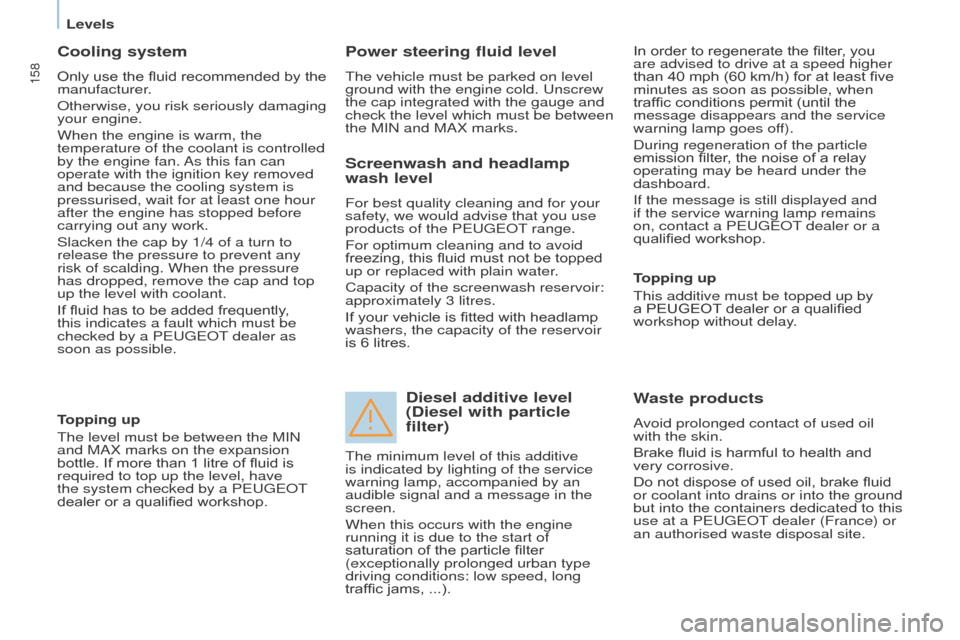
158
Cooling system
Only use the fluid recommended by the
manufacturer.
o
therwise, you risk seriously damaging
your engine.
When the engine is warm, the
temperature of the coolant is controlled
by the engine fan. As this fan can
operate with the ignition key removed
and because the cooling system is
pressurised, wait for at least one hour
after the engine has stopped before
carrying out any work.
Slacken the cap by 1/4 of a turn to
release the pressure to prevent any
risk of scalding. When the pressure
has dropped, remove the cap and top
up the level with coolant.
If fluid has to be added frequently,
this indicates a fault which must be
checked by a P
eugeo T dealer as
soon as possible.
Power steering fluid level
The vehicle must be parked on level
ground with the engine cold. u nscrew
the cap integrated with the gauge and
check the level which must be between
the MIN and MAX marks. In order to regenerate the filter, you
are advised to drive at a speed higher
than 40 mph (60 km/h) for at least five
minutes as soon as possible, when
traffic conditions permit (until the
message disappears and the service
warning lamp goes off).
During regeneration of the particle
emission filter, the noise of a relay
operating may be heard under the
dashboard.
If the message is still displayed and
if the service warning lamp remains
on, contact a P
eugeo T dealer or a
qualified workshop.
topping up
The level must be between the MIN
and MAX marks on the expansion
bottle. If more than 1 litre of fluid is
required to top up the level, have
the system checked by a P
eugeo
T
dealer or a qualified workshop.
Screenwash and headlamp
wash level
For best quality cleaning and for your
safety, we would advise that you use
products of the P
eugeo T range.
For optimum cleaning and to avoid
freezing, this fluid must not be topped
up or replaced with plain water.
Capacity of the screenwash reservoir:
approximately 3 litres.
If your vehicle is fitted with headlamp
washers, the capacity of the reservoir
is 6 litres.
Diesel additive level
(Diesel with particle
filter)
topping up
This additive must be topped up by
a PEUGEOT
dealer or a qualified
workshop without delay.
Waste products
Avoid prolonged contact of used oil
with the skin.
Brake fluid is harmful to health and
very corrosive.
Do not dispose of used oil, brake fluid
or coolant into drains or into the ground
but into the containers dedicated to this
use at a P
eugeo T dealer (France) or
an authorised waste disposal site.
The minimum level of this additive
is indicated by lighting of the service
warning lamp, accompanied by an
audible signal and a message in the
screen.
When this occurs with the engine
running it is due to the start of
saturation of the particle filter
(exceptionally prolonged urban type
driving conditions: low speed, long
traffic jams, ...).
Levels
Page 162 of 296
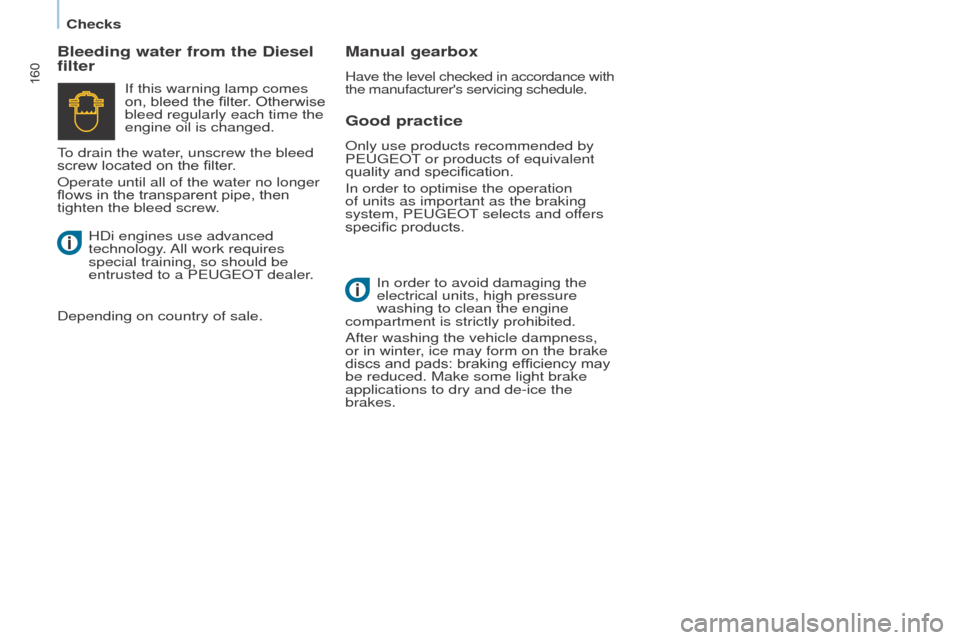
160
Checks
good practice
only use products recommended by
P eugeo T or products of equivalent
quality and specification.
In order to optimise the operation
of units as important as the braking
system, P
eugeo T selects and offers
specific products.
Bleeding water from the Diesel
filter Manual gearbox
Have the level checked in accordance with
the manufacturer's servicing schedule.
In order to avoid damaging the
electrical units, high pressure
washing to clean the engine
compartment is strictly prohibited.
After washing the vehicle dampness,
or in winter, ice may form on the brake
discs and pads: braking efficiency may
be reduced. Make some light brake
applications to dry and de-ice the
brakes.
If this warning lamp comes
on, bleed the filter. Otherwise
bleed regularly each time the
engine oil is changed.
HDi engines use advanced
technology
. All work requires
special training, so should be
entrusted to a P
eugeo
T dealer.
Depending on country of sale. To drain the water, unscrew the bleed
screw located on the filter.
o
perate until all of the water no longer
flows in the transparent pipe, then
tighten the bleed screw.
Page 163 of 296
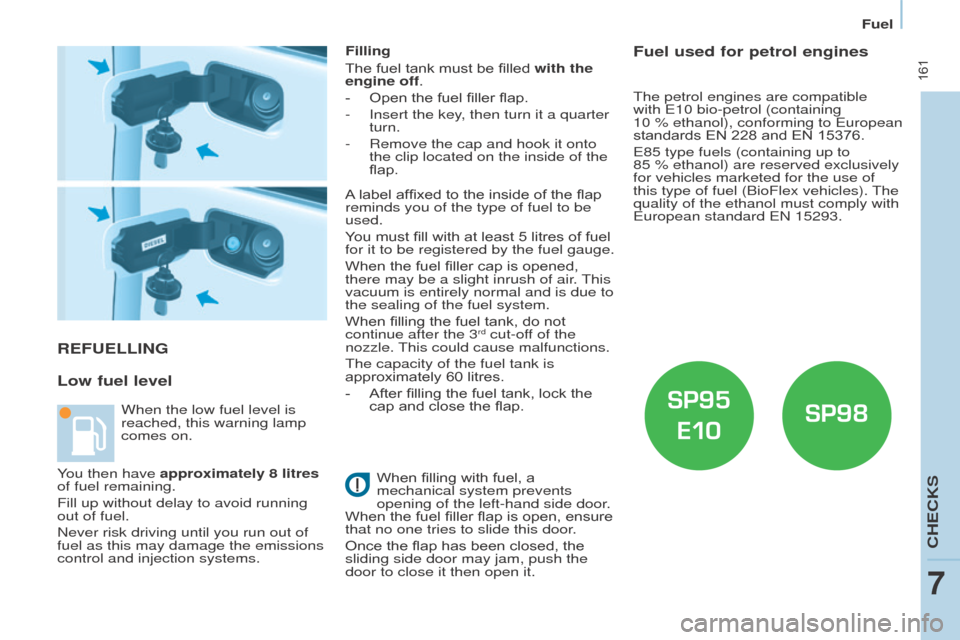
161
ReFueLLINg
Low fuel level
Filling
The fuel tank must be filled with the
engine off.
-
Open the fuel filler flap.
-
Insert the key
, then turn it a quarter
turn.
-
Remove the cap and hook it onto
the clip located on the inside of the
flap.
When fillin
g with fuel, a
mechanical system prevents
opening of the left-hand side door.
When the fuel filler flap is open, ensure
that no one tries to slide this door.
Once the flap has been closed, the
sliding side door may jam, push the
door to close it then open it.
When the low fuel level is
reached, this warning lamp
comes on. A label affixed to the inside of the flap
reminds you of the type of fuel to be
used.
You must fill with at least 5 litres of fuel
for it to be registered by the fuel gauge.
When the fuel filler cap is opened,
there may be a slight inrush of air. This
vacuum is entirely normal and is due to
the sealing of the fuel system.
When filling the fuel tank, do not
continue after the 3
rd cut-off of the
nozzle. This could cause malfunctions.
The capacity of the fuel tank is
approximately 60 litres.
-
After fillin
g the fuel tank, lock the
cap and close the flap.
Fuel used for petrol engines
The petrol engines are compatible
with e 10 bio-petrol (containing
10
% ethanol), conforming to e uropean
standards EN 228 and EN 15376.
e
85 type fuels (containing up to
85
% ethanol) are reserved exclusively
for vehicles marketed for the use of
this type of fuel (BioFlex vehicles). The
quality of the ethanol must comply with
e
uropean standard e N 15293.
You then have approximately 8 litres
of fuel remaining.
Fill up without delay to avoid running
out of fuel.
Never risk driving until you run out of
fuel as this may damage the emissions
control and injection systems.
CHeCKS
7
Fuel
Page 164 of 296
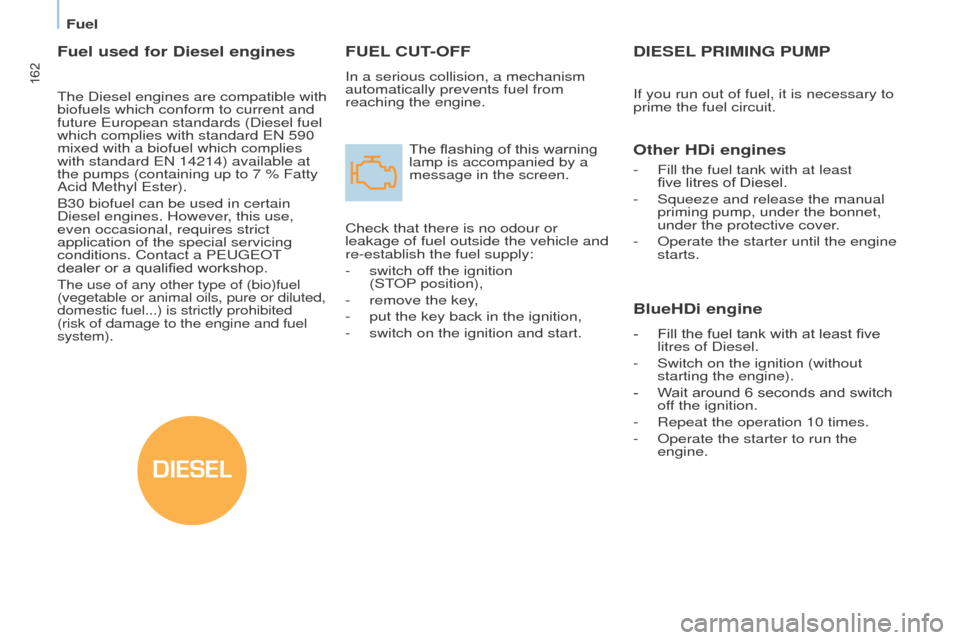
DIESEL
162
FueL C ut-o FF
In a serious collision, a mechanism
automatically prevents fuel from
reaching the engine.
The flashing of this warning
lamp is accompanied by a
message in the screen.
Check that there is no odour or
leakage of fuel outside the vehicle and
re-establish the fuel supply:
-
switch of
f the ignition
(ST
o
P
position),
-
remove the key
,
-
put the key back in the ignition,
-
switch on the ignition and start.
DIeSeL PRIMIN g P u MPFuel used for Diesel engines
The Diesel engines are compatible with
biofuels which conform to current and
future
e uropean standards (Diesel fuel
which complies with standard
e N 590
mixed with a biofuel which complies
with standard
e N 14214) available at
the pumps (containing up to 7 % Fatty
Acid Methyl
e ster).
B30 biofuel can be used in certain
Diesel engines. However, this use,
even occasional, requires strict
application of the special servicing
conditions. Contact a P
eugeo T
dealer or a qualified workshop.
The use of any other type of (bio)fuel
(vegetable or animal oils, pure or diluted,
domestic fuel...) is strictly prohibited
(risk of damage to the engine and fuel
system).
If you run out of fuel, it is necessary to
prime the fuel circuit.
other HDi engines
- Fill the fuel tank with at least
five litres of Diesel.
-
Squeeze and release the manual
priming pump, under the bonnet,
under the protective cover
.
-
o perate the starter until the engine
starts.
BlueHDi engine
- Fill the fuel tank with at least five
litres of Diesel.
-
Switch on the ignition (without
starting the engine).
-
W
ait around 6 seconds and switch
off the ignition.
-
Repeat the operation 10 times.
-
o perate the starter to run the
engine.
Fuel
Page 165 of 296
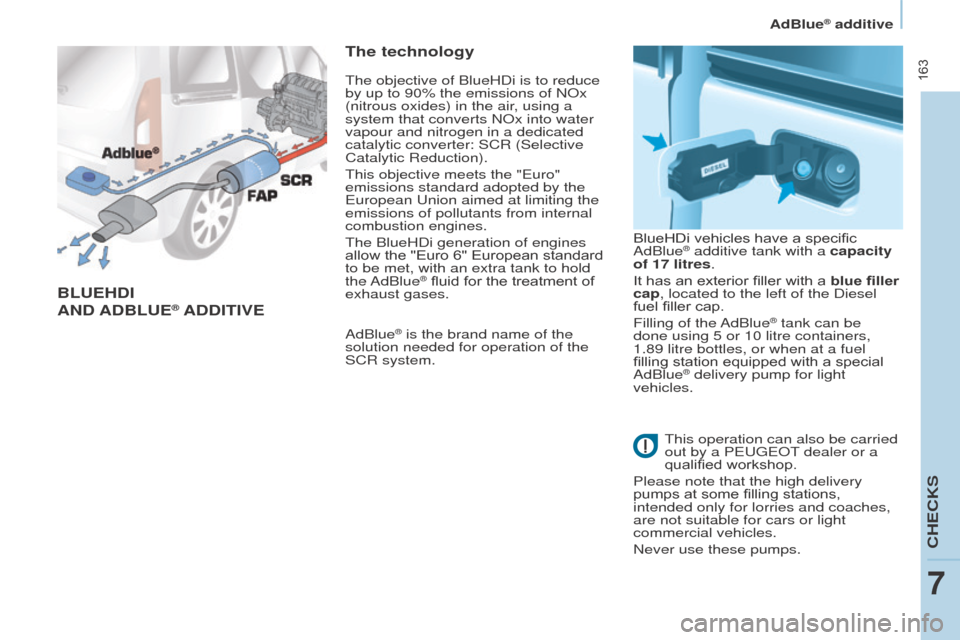
163
BLueHDI
AND A D B L ue® ADDItIVe
t
he technology
AdBlue® is the brand name of the
solution needed for operation of the
SCR system. BlueHDi vehicles have a specific
AdBlue
® additive tank with a capacity
of 17 litres.
It has an exterior filler with a blue filler
cap, located to the left of the Diesel
fuel filler cap.
Filling of the AdBlue
® tank can be
done using 5 or 10 litre containers,
1.89 litre bottles, or when at a fuel
filling station equipped with a special
AdBlue
® delivery pump for light
vehicles.
The objective of BlueHDi is to reduce
by up to 90% the emissions of N
o
x
(nitrous oxides) in the air, using a
system that converts N
o
x into water
vapour and nitrogen in a dedicated
catalytic converter: SCR (Selective
Catalytic Reduction).
This objective meets the "
e
uro"
emissions standard adopted by the
e
uropean
u
nion aimed at limiting the
emissions of pollutants from internal
combustion engines.
The BlueHDi generation of engines
allow the "Euro 6" European standard
to be met, with an extra tank to hold
the AdBlue
® fluid for the treatment of
exhaust gases.
This operation can also be carried
out by a P
eugeo T dealer or a
qualified workshop.
Please note that the high delivery
pumps at some filling stations,
intended only for lorries and coaches,
are not suitable for cars or light
commercial vehicles.
Never use these pumps.
CHeCKS
7
AdBlue® additive
Page 167 of 296

165
Range indicators
Rules on the display of alertsFor more information on the
displays and warning lamps, refer
to chapter 3, "Instruments and
controls" section. Range greater than 1 500 miles
(2 400 km)
No information displayed.
o
nce the 1 500 miles (2 400 km)
threshold is reached, the
u R e A
warning lamp comes on temporarily
and the remaining range message is
displayed.
The alert is repeated every 200 miles
(300 km) until the next threshold is
reached.
e
very time the ignition is switched
on, the alert is given, together with an
audible signal. Remaining range less than 1 500
miles
(2 400 km) and greater than 350 miles
(600 km)
Driving range
With the touch screen:
If the range is greater than 3 000 miles
(5 000 km), a range value is not given. Press this button to display
the information.
-
select the "Driving
assistance" menu,
-
select "Diagnostic",
-
select CH
e CK.
Different levels of alert are triggered
according to the remaining driving
range threshold
You will be informed as each mileage
threshold is reached and the alerts will
change from temporary to permanent.
-
The 1st is triggered at a remaining
driving range of 1 500 miles
(2 400 km).
-
The 2nd is triggered at a remaining
driving range of 350 miles (600 km).
-
u
p to 0 miles, at which point it will
be impossible to restart the engine
after a stop.
CHeCKS
7
AdBlue® additive
Page 169 of 296
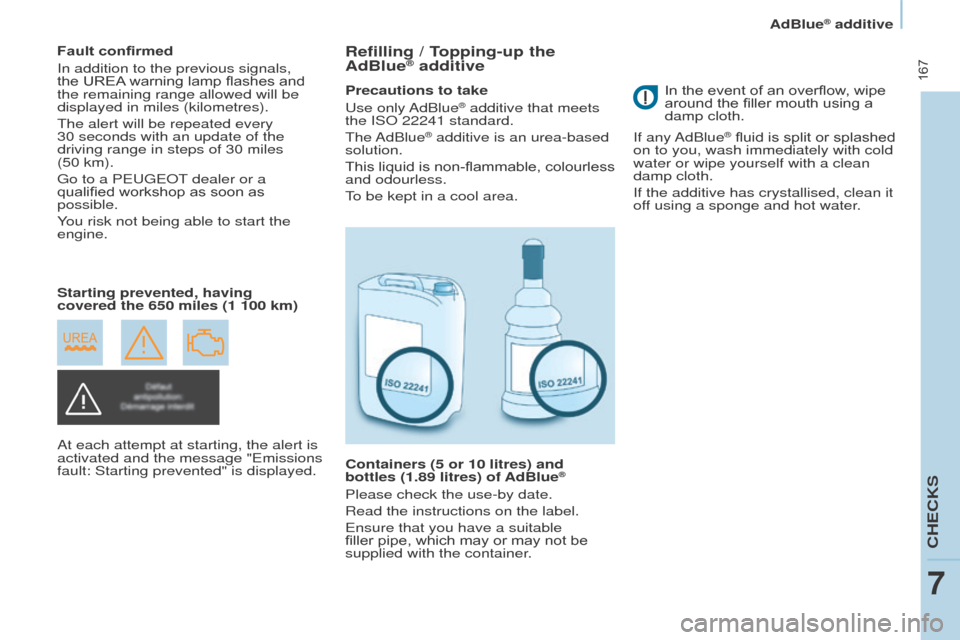
167
Fault confirmed
In addition to the previous signals,
the UREA warning lamp flashes and
the remaining range allowed will be
displayed in miles (kilometres).
The alert will be repeated every
30 seconds with an update of the
driving range in steps of 30 miles
(50 km).
g
o to a P eugeo T dealer or a
qualified workshop as soon as
possible.
You risk not being able to start the
engine.
Starting prevented, having
covered the 650 miles (1 100 km)
At each attempt at starting, the alert is
activated and the message "
e missions
fault: Starting prevented" is displayed.Refilling / topping-up the
AdBlue® additive
Precautions to take
u
se only AdBlue® additive that meets
the IS
o
22241 standard.
The AdBlue
® additive is an urea-based
solution.
This liquid is non-flammable, colourless
and odourless.
To be kept in a cool area.
Containers (5 or 10 litres) and
bottles (1.89 litres) of AdBlue
®
Please check the use-by date.
Read the instructions on the label.
e
nsure that you have a suitable
filler pipe, which may or may not be
supplied with the container. In the event of an overflow, wipe
around the filler mouth using a
damp cloth.
If any AdBlue
® fluid is split or splashed
on to you, wash immediately with cold
water or wipe yourself with a clean
damp cloth.
If the additive has crystallised, clean it
off using a sponge and hot water.
CHeCKS
7
AdBlue® additive
Page 171 of 296

169
BAtteRY
Before disconnecting the battery, you
must wait for 2 minutes after switching
off the ignition.
Never disconnect a terminal when the
engine is running.
Never charge a battery without first
disconnecting the terminals.
After every reconnection of the battery,
switch on the ignition and wait 1 minute
before starting to allow the electronic
systems to be initialised. If problems
remain after doing this, please contact
a PEUGEOT dealer or a qualified
workshop.
After changing bulbs, wait
approximately 3 minutes before
reconnecting the battery.
It is advisable to disconnect the
battery if the vehicle is not to be
used for a period of more than
one
month.
to charge the battery using
a battery charger
- Disconnect the battery .
-
Follow the instructions for use
given by the battery charger
manufacturer
.
-
Reconnect starting with the
negative (-) terminal.
-
Check that the terminals and
connectors are clean. If they are
covered with sulphate (white or
greenish deposit), disconnect them
and clean them.
to start the vehicle from
another battery
- Connect the red cable to the
positive (+) terminals of the
two
batteries.
-
Connect one end of the green
or black cable to the negative (-)
terminal of the slave battery
.
-
Connect the other end of the green
or black cable to an earth point on
the broken down vehicle as far as
possible from the battery
.
-
o perate the starter, let the engine run.
-
W
ait for the engine to return to idle,
then disconnect the cables.
The presence of this label
indicates the use of a 12 V
lead-acid battery with special
technology and specification, for which
the involvement of a P
eugeo
T dealer
or qualified workshop is required when
replacing or disconnecting the battery.
Failure to observe this
recommendation may cause premature
wear of the battery.
After refitting the battery, the Stop
&
Start system will only be active after
several hours depending on the
climatic conditions and the state of
charge of the battery (up to about
8 hours).
The Stop & Start battery does not have
to be disconnected for charging.
Battery
8
QuICK HeLP
Page 269 of 296

267
QueStIoNA NSWeRS oLutIoN
T
here is a difference in
sound quality between the
different audio sources. For optimum sound quality, the audio settings for Volume, Bass,
Treble,
e
q
ualizer and Loudness can be adapted to the different
sound sources, which may result in audible differences when
changing source. Check that the audio settings for (Volume, Bass,
Treble,
e
q
ualizer, Loudness) are adapted to the
sources listened to. It is advisable to set the
audio functions (Bass, Treble, Fr-Re balance,
Le-Ri balance) to the middle position, select the
"Linear", musical ambience and set the loudness
correction to the "Inactive" position in radio
mode.
With the engine off, the
system switches off after a
few minutes of use. When the engine is switched off, the system's operating time
depends on the state of charge of the battery.
The switch-off is normal: the system switches to economy mode
and switches off to prevent discharging of the vehicle's battery. Start the vehicle's engine to increase the battery
charge.
Audio and telematics
teCHNoLogY on BoARD
10
Page 286 of 296

284
The table below gives answers to the most frequently asked questions on your audio system.Q
ueStIoN A
NSW
eRS
o
LutIoN
W
ith the engine off, the
audio system switches off
after a few minutes of use. When the engine is switched off, the audio system operating time
depends on the state of charge of the battery.
The switch-off is normal: the audio equipment switches to economy
mode and switches off to prevent discharging of the vehicle's
battery. Start the vehicle's engine to increase the battery
charge.
The message "the audio
system is overheated"
appears on the display. In order to protect the installation if the surrounding temperature
is too high, the audio system switches to an automatic thermal
protection mode leading to a reduction in volume or CD play
stopping. Switch the audio system off for a few minutes to
allow the system to cool.
Frequently asked questions
QueStIoN
A NSWeRS oLutIoN
T
here is a difference in
sound quality between the
different audio sources
(radio, CD...). For optimum sound quality, the audio settings (Volume, Bass,
Treble, Ambience, Loudness) can be adapted to the different sound
sources, which may result in audible differences when changing
source (radio, CD...). Check that the audio settings (Volume, Bass,
Treble, Ambience, Loudness) are adapted to
the sources listened to. It is advisable to set
the audio functions (Bass, Treble, Front-Rear
Balance, Left-Right Balance) to the middle
position, select the musical ambience "None"
and set the loudness correction to the "Active"
position in CD mode or to the "Inactive" position
in radio mode.
Radio
Audio and Telematics